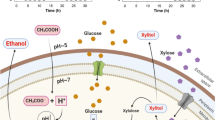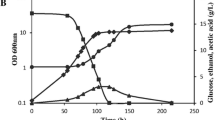Abstract
Different nitriles were used as sole sources of nitrogen in a series of enrichments under acidic conditions to isolate acidotolerant nitriles hydrolysing microorganisms. From an enrichment in Na–citrate–phosphate buffer at pH 4 with glucose as carbon source and phenylacetonitrile as sole source of nitrogen, a black yeast (strain R1) was obtained which was identified by subsequent 18S rRNA gene sequencing as Exophiala oligosperma. The growth conditions of the organism were optimized for the production of cell material and the induction of the nitrile converting activity. Resting cell experiments demonstrated that phenylacetonitrile was converted via phenylacetic acid and 2-hydroxyphenylacetic acid. The organism could grow at pH 4 with phenylacetonitrile as sole source of carbon, nitrogen, and energy. The nitriles hydrolysing activity was also detected in cell-free extracts and indications for a nitrilase activity were found. The cell-free extracts converted, in addition to phenylacetonitrile, also different substituted phenylacetonitriles. Whole cells of E. oligosperma R1 converted phenylacetonitrile with almost the same reaction rates in the pH range from pH 1.5–pH 9.








Similar content being viewed by others
References
Bossler AD, Richter SS, Chavez AJ, Vogelgesang SA, Sutton DA, Grooters AM, Rinaldi MG, de Hoog GS, Pfaller MA (2003) Exophiala oligosperma causing olecranon bursitis. J Clin Microbiol 41:4779–4782
Bradford MM (1976) A rapid and sensitive method for the quantitation of microgram quantities of protein utilizing the principle of protein dye binding. Anal Biochem 72:248–254
Bragulat MR, Abarca ML, Bruguera MT, Cabanes FJ (1991) Dyes as fungal inhibitors: effect on colony diameter. Appl Environ Microbiol 57:2777–2780
Brewis E, Van der Walt JP, Prior BA (1995) The utilization of aromatic, cyclic and heterocyclic nitriles by yeasts. Syst Appl Microbiol 18:338–342
Bunch AW (1998) Nitriles. In: Rehm HJ, Reed G (eds) Biotechnology, Vol 8a, Biotransformations I, Chap. 6. Wiley-VCH, Weinheim, pp. 277–324
Cox HH, Faber BW, Van Heiningen WN, Radhoe H, Doddema HJ, Harder W (1996) Styrene metabolism in Exophiala jeanselmei and involvement of a cytochrome P-450-dependent styrene monooxygenase. Appl Environ Microbiol 62:1471–1474
De Hoog GS, Vicente V, Caligiorne RB, Kantarcioglu S, Tintelnot K, Gerrits van den Ende AH, Haase G (2003) Species diversity and polymorphism in the Exophiala spinifera clade containing opportunistic black yeast-like fungi. J Clin Microbiol 41:4767–4778
De Hoog GS, Zeng JS, Harrak MJ, Sutton DA (2006) Exophiala xenobiotica sp. nov., an opportunistic black yeast inhabiting environments rich in hydrocarbons. Antonie van Leeuwenhoek 90:257–268
Dias JCT, Rezende RP, Rosa CA, Lachanche M-A, Linardi VR (2000) Enzymatic degradation of nitriles by a Candidda guilliermodii UFMG-Y65. Can J Microbiol 46:525–531
Estevez E, Veiga MC, Kennes C (2005a) Biodegradation of toluene by the new fungal isolates Paecilomyces variotii and Exophiala oligosperma. J Ind Microbiol Biotech 32:33–37
Estevez E, Veiga MC, Kennes C (2005b) Biofiltration of waste gases with the fungi Exophiala oligosperma and Paecilomyces variotii. Appl Microbiol Biotechnol 67:563–568
Fukuda Y, Harada T, Izumi Y (1973) Formation of l-α-hydroxyacids from dl-α-hydroxynitriles by Torulopsis candida GN405. J Ferment Technol 51:393–397
Goldlust A, Bohak Z (1989) Induction, purification and characterization of the nitrilase of Fusarium oxysporum f. sp. melonis. Biotech Appl Biochem 11:581–601
Gunsch CK, Cheng Q, Kinney KA, Szaniszlo PJ, Whitman CP (2005) Identification of a homogentisate-1,2-dioxygenase gene in the fungus Exophiala lecanii-corni: analysis and implications. Appl Microbiol Biotechnol 68:405–411
Harper DB (1977) Fungal degradation of aromatic nitriles. Enzymology of C-N cleavage by Fusarium solani. Biochem J 167:685–692
Hasegawa Y, Nakai Y, Tokuyama T, Iwaki H (2000) Purification and characterization of cyclohexanone 1,2-monooxygenase from Exophiala jeanselmei strain KUFI-6N. Biosci Biotechnol Biochem 64:2696–2698
Hocking AD, Pitt JI (1980) Dichloran–glycerol medium for enumeration of xerophilic fungi from low-moisture foods. Appl Environ Microbiol 39:488–492
Hölker U, Bend J, Pracht R, Tetsch L, Müller T, Höfer M, de Hoog GS (2004) Hortaea acidophila, a new acid-tolerant black yeast from lignite. Antonie van Leeuwenhoek 86:287–294
Kaplan O, Nikolaou K, Pišvejcová A, Martinková L (2006a) Hydrolysis of nitriles and amides by filamentous fungi. Enzyme Microb Technol 38:260–264
Kaplan O, Vejvoda V, Charvatova-Pisvejcova A, Martinkova L (2006b) Hyperinduction of nitrilases in filamentous fungi. J Ind Microbiol Biotech 33:891–896
Kaplan O, Vejvoda V, Plíhal O, Pompach P, Kavan D, Fialová P, Bezouška K, Macková M, Cantarella M, Jirků V, Křen V, Martínková L. (2006c) Purification and characterization of a nitrilase from Aspergillus niger K10. Appl Microbiol Biotechnol 73:567–575
Kiziak C, Conradt D, Stolz A, Mattes R, Klein J (2005) Nitrilase from Pseudomonas fluorescens EBC 191: cloning and heterologous expression of the gene and biochemical characterization of the recombinant enzyme. Microbiology 151:3639–3648
Kuwahara M, Yanase H, Ishida Y, Kikuchi Y (1980) Metabolism of aliphatic nitriles in Fusarium solani. J Ferment Technol 58:573–577
Linardi, VR, Dias JCT, Rosa CA (1996) Utilisation of acetonitrile and other aliphatic nitriles by a Candida famata strain. FEMS Microbiol Lett 44:67–71
Martinková L, Křen V (2002) Nitrile- and amide-converting microbial enzymes: stereo-, regio- and chemoselectivity. Biocatal Biotransform 20:73–93
Mateo C, Chmura A, Rustler S, van Rantwijk F, Stolz A, Sheldon RA (2006) Synthesis of enantiomerically pure (S)-mandelic acid using an oxynitrilase-nitrilase bienzymatic cascade. A nitrilase surprisingly shows nitrile hydratase activity. Tetrahedron Asymmetry 17:320–323
Meier J, Babenzien H-D, Wendt-Potthoff K (2004) Microbial cycling of iron and sulfur in sediments of acidic and pH-neutral mining lakes in Lusatia (Brandenburg, Germany). Biogeochemistry 67:135–156
Pfennig M, Lippert KD (1966) Über das Vitamin B12-Bedürfnis phototropher Schwefelbakterien. Arch Mikrobiol 55:245–256
Prenafeta-Boldu FX, Summerbell R, de Hoog GS (2006) Fungi growing on aromatic hydrocarbons: biotechnology’s unexpected encounter with biohazard? FEMS Microbiol Rev 30:109–130
Qi B, Moe WM, Kinney KA (2002) Biodegradation of volatile organic compounds by five fungal species. Appl Microbiol Biotechnol 58:684–689
Rezende RP, Dias JCT, Rosa CA, Carazza F, Linardi VR (1999) Utilisation of nitriles by yeasts strains isolated from a Brazilian gold mine. J Gen Appl Microbiol 45:185–192
Rezende RP, Dias JCT, Ferraz V, Linardi VR (2000) Metabolism of benzonitrile by Cryptococcus sp. UFMG-Y28. J Basic Microbiol 40:389–392
Rustler S, Müller A, Windeisen V, Chmura A, Fernandes B, Kiziak C, Stolz A (2007) Conversion of mandelonitrile and phenylglycinenitrile by recombinant E. coli cells synthesizing a nitrilase from Pseudomonas fluorescens EBC191. Enzyme Microb Technol 40:598–606
Schulze B (2002) Hydrolysis and formation of C-N bonds. Chapter 12. In: Drauz, K, Waldmann, H (ed) Enzyme catalysis in organic synthesis vol. II. Wiley-VCH, Weinheim, pp. 699–715
Stach JE, Burns RG (2002) Enrichment versus biofilm culture: a functional and phylogenetic comparison of polycyclic aromatic hydrocarbon-degrading microbial communities. Environ Microbiol 4:169–182
Sterflinger K, Prillinger H (2001) Molecular taxonomy and biodiversity of rock fungal communities in an urban environment (Vienna, Austria). Antonie van Leeuwenhoek 80:275–286
Untereiner WA, Naveaeu FA (1999) Molecular systematics of the Herpotrichiellaceae with an assessment of the phylogenetic positions of Exophiala dermatitidis and Phialophora americana. Mycologia 91:67–83
Untereiner WA, Straus NA, Malloch D (1995) A molecular-morphotaxonomic approach to the systematics of the Herpotrichiellaceae and allied black yeasts. Mycol Res 99:897–913
Van der Walt, JP, Brewis EA, Prior BA (1993) A note on the utilization of aliphatic nitriles by yeasts. Syst Appl Microbiol 16:330–332
Woertz JR, Kinney KA, McIntosh ND, Szaniszlo PJ (2001) Removal of toluene in a vapor-phase bioreactor containing a strain of the dimorphic black yeast Exophiala lecanii-corni. Biotechnol Bioeng 75:550–558
Acknowledgements
We thank Dr. Katrin Wendt-Potthof and Dr. Mathias Koschorreck (UFZ, Leipzig/Halle, Germany) for the sample from “Restsee 111” and B. Jones (Bangor Wales) for a sample of acid mine drainage from Parys Mountain, North Wales. Furthermore, we are grateful to P. Hoffmann (Deutsche Sammlung von Mikroorganismen und Zellkulturen, DSMZ, Braunschweig, Germany) and G.S. de Hoog (Centraalbureau voor Schimmelcultures, Utrecht, The Netherlands) for their help in identification of E. oligospermum.
The work was supported in the framework of the CERC3 program.
Author information
Authors and Affiliations
Corresponding author
Rights and permissions
About this article
Cite this article
Rustler, S., Stolz, A. Isolation and characterization of a nitrile hydrolysing acidotolerant black yeast—Exophiala oligosperma R1. Appl Microbiol Biotechnol 75, 899–908 (2007). https://doi.org/10.1007/s00253-007-0890-3
Received:
Revised:
Accepted:
Published:
Issue Date:
DOI: https://doi.org/10.1007/s00253-007-0890-3




